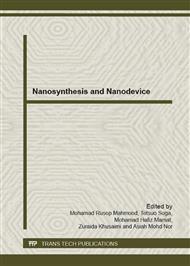[1]
N. A. Zabidi, H. A. Kassim, K. N. Shrivastava, Energy band crossing points in multilayers of graphene, AIP Conf. Proc. 1017 (2008) 326-330.
DOI: 10.1063/1.2940653
Google Scholar
[2]
K. N. Shrivastava, The theory of the quantum Hall effect, AIP Conf. Proc. 1017 (2008) 422-428.
Google Scholar
[3]
K. N. Shrivastava, Infrared of thin film graphene in a magnetic field and the Hall effect, Proc. SPIE 7155 (2008) 71552F.
Google Scholar
[4]
K. N. Shrivastava, Interpretation of fractions in quantum Hall effect, Wei Pan's data 1150 (2009) 59-67.
Google Scholar
[5]
W. Kohn, Cyclotron resonance and de Haas-van Alphen oscillations of an interacting electron gas, Phys. Rev. 123 (1961) 1242-1244.
DOI: 10.1103/physrev.123.1242
Google Scholar
[6]
E. A. Henriksen, P. Cadden-Zimansky, Z. Jiang, Z. Q. Li, L. -C. Tung, M. E. Schwartz, M. Takita, Y. -J. Wang, P. Kim, H. L. Stromer, Interaction-induced shift of the cyclotron resonance of graphene using infrared spectroscopy, Phys. Rev. Lett. 104 (2010).
DOI: 10.1103/physrevlett.104.067404
Google Scholar
[7]
J. Hubbard, Proc. R. Soc. A 240 (1957) 539.
Google Scholar
[8]
F. H. L. Essler, H. Frahm, F. Gohmann, A. Klumper, The One-dimensional Hubbard model, Cambridge University Press, (2005).
Google Scholar
[9]
R. Peierls, Z. Phys. 80 (1933) 763.
Google Scholar
[10]
J. M. Luttinger, The effect of a magnetic field on electrons in a periodic potential, Phys. Rev. 84 (1951) 814-817.
DOI: 10.1103/physrev.84.814
Google Scholar
[11]
K. N. Shrivastava, Rational numbers of the fractionally quantized Hall effect, Phys. Lett. A113 (1986) 435-436.
DOI: 10.1016/0375-9601(86)90667-5
Google Scholar
[12]
K. N. Shrivastava, Negative-spin quasiparticles in quantum Hall effect, Phys. Lett. A 326 (2004) 469-472.
DOI: 10.1016/j.physleta.2004.04.067
Google Scholar
[13]
K. N. Shrivastava, Particle-hole symmetry in quantum Hall effect, Mod. Phys. Lett. 13 (1999) 1087-1090.
DOI: 10.1142/s0217984999001342
Google Scholar
[14]
K. N. Shrivastava, Theory of quantum Hall effect with high Landau levels, Mod. Phys. Lett. B 14 (2000) 1009-1013.
DOI: 10.1142/s0217984900001294
Google Scholar
[15]
K. N. Shrivastava, The fractional quantum Hall effect: The cases of 5/2 and 12/5, AIP Conf Proc. 1169 (2009) 48-54.
Google Scholar
[16]
K. N. Shrivastava, Pfaffian states: Quantum computation, AIP Conf. Proc. 1169 (2009) 241-246.
Google Scholar
[17]
K. N. Shrivastava, Plateau-to-plateau phase transition in quantum Hall effect, AIP Conf. Proc. 1250 (2010) 27-30.
Google Scholar
[18]
K. N. Shrivastava, Byers and Yang's theorem on flux quantization, AIP Conf. Proc. 1250 (2010) 261-264.
Google Scholar
[19]
K. N. Shrivastava, Introduction to quantum Hall effect, Nova Sci. Pub. New York, (2002).
Google Scholar
[20]
K. N. Shrivastava, Quantum Hall effect: Expressions, Nova Sci. Pub. New York, (2005).
Google Scholar
[21]
K. N. Shrivastava, Electron spin in quantum Hall effect: D. C. Tsui's data, Applied Mechanics and Materials, Wu Fan (ed. ), 110-116(2011)3097-3102.
Google Scholar
[22]
K. von Klitzing, G. Dorda, M. Pepper, New method for high-accuracy determination of the fine structure constant, Phys. Rev. Lett. 45 (1980) 494-497.
DOI: 10.1103/physrevlett.45.494
Google Scholar
[23]
D. C. Tsui, H. L. Stormer, A. C. Gossard, Two-dimensional magnetotransport in the extreme quantum limit, Phys. Rev. Lett. 48 (1982) 1559-1562.
DOI: 10.1103/physrevlett.48.1559
Google Scholar
[24]
L. H. Thomas, Nature 117 (1926) 514.
Google Scholar
[25]
K. N. Shrivastava, The quantum Hall effect, AIP Conf. Proc. 1482 (2012) 335-339.
Google Scholar



